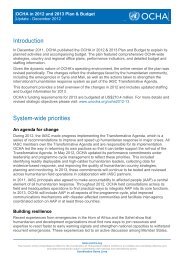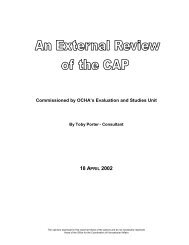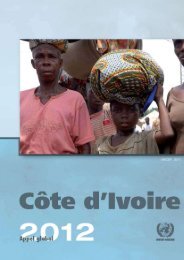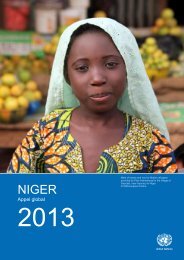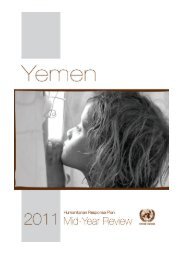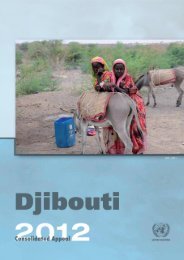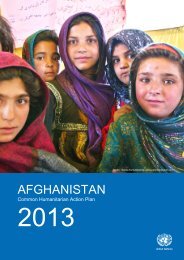SUDAN
Sudan: UN and Partners Work Plan 2012 - ReliefWeb
Sudan: UN and Partners Work Plan 2012 - ReliefWeb
- No tags were found...
Create successful ePaper yourself
Turn your PDF publications into a flip-book with our unique Google optimized e-Paper software.
United Nations and Partners[2] NEEDS Analysis<strong>SUDAN</strong> WORK PLAN 201231Seasonal calander and critical events(Sudan, April 2011 to April 2012)Hunger seasonWheatharvest(irrigated)LandpreparationPlantingMillet and sorghumharvestLandpreparationDryseasonRainy seasonWinter season plantingDryseasonApr ‘11May Jun Jul Aug Sep Oct Nov Dec JanFeb Mar Apr ‘12Source: FEWSNET (2011)Priority needs in conflictand disaster-affected areasThe prioritization of needs is based on the internationallydefined main outcomes of the effects of humanitarian crisison communities –excess mortality, excess morbidity and lifewithout dignity. The humanitarian needs of highest priority inconflict and disaster-affected areas in Sudan are:Food Security and livelihoods (FSL)Food security continues to be one of the key humanitarianconcerns in Sudan. In areas such as Darfur, an estimated 4.2million people – nearly half the population - received someform of food assistance, depending on the season. Throughoutthe country, however, food security varies greatly, as illustratedby the September 2011 updated version of IntegratedFood Security Phase Classification (IPC) map. Householdsheaded by women are more likely to be food-deprived thanhouseholds headed by men, with education and employmentbeing the main factors factors affecting this gender disparity.Causes of food insecurityThere are a number of factors that combine to make foodinsecurity a persistent problem in Sudan: an under-developedand mainly rain-fed agriculture, poverty and lack of livelihoodsopportunities, and the reliance on importing key food itemswhich are subject to fluctuating world prices. In addition, lowrainfall is likely to lead to a poor harvest during 2011, withlower yields expected than last year and the five-year average.The most affected areas will be Darfur and eastern Sudan, aswell as the three Protocol Areas, where the combination ofpoor rains and insecurity is expected to reduce the harvest toa quarter of normal levels.The price inflation of staple foods has increased by approximately25 percent during 2011. This has already affected thefood security situation of the most vulnerable groups (IDPs,returnees, refugees and the extremely poor resident hostcommunities) - the poorest 20 percent of the populationspends about 72 percent of their income on food.LivelihoodsThere are a number of factors that combine to make foodinsecurity a persistent problem in Sudan: an under-developedand mainly rain-fed agriculture, poverty and lack of livelihoodsopportunities, and the reliance on importing key food itemswhich are subject to fluctuating world prices. In addition, lowrainfall is likely to lead to a poor harvest during 2011, withlower yields expected than last year and the five-year average.The most affected areas will be Darfur and eastern Sudan, aswell as the three Protocol Areas, where the combination ofpoor rains and insecurity is expected to reduce the harvest toa quarter of normal levels.The price inflation of staple foods has increased by approximately25 percent during 2011. This has already affected thefood security situation of the most vulnerable groups (IDPs,returnees, refugees and the extremely poor resident hostcommunities) - the poorest 20 percent of the populationspends about 72 percent of their income on food.NutritionLike food insecurity and displacement, the disruption of livelihoodsand food production has a profound impact on nutritionstatus, increasing the potential for malnutrition. Localizedsurveys across Sudan indicate that the nutrition situation inSudan has not improved in any significant way in the last 25years, with around 40 percent of under-5 children chronicallymalnourished, and 16 percent of children acutely malnourished.Also, 27 percent of under-5 children are reported asunderweight, and 31 percent of infants are reported with a lowbirth weight (birth weight < 2500 grams). In Darfur, differencesin the acute malnutrition rate are observed seasonally, withyounger children consistently exhibiting signs of acute malnutritionmore often. This is attributed in large part to suboptimalinfant and young child feeding (IYCF) practices.At 16.4 percent, acute malnutrition levels in Sudan as a wholeare above the internationally accepted emergency thresholdof 15 percent; moreover, 5.3 percent of the children areseverely acutely malnourished. In Darfur, the General AcuteMalnutrition (GAM) rate fluctuates according to the season,ranging from 8.7 percent in South Darfur during the postharvestseason to over 35 percent in North Darfur duringthe lean season. Only five localized surveys were conductedoutside the Darfur states in 2011. GAM results from thesesurveys range from 8.2 percent to 16.5 percent.This means that more than half a million children are likelyto be severely acutely malnourished over one year in Sudanand just under 1.5 million children will suffer from moderate




